Mushroom art is a creative genre that features fungi as the central theme, exploring their unique shapes, colors, and textures. It spans various mediums, including painting, sculpture, and digital art, often highlighting the natural beauty and ecological significance of mushrooms. This artistic expression can also delve into symbolic meanings, connecting mushrooms with themes of mystery, transformation, and the interconnectedness of life.
Mushroom art captures the intricate and often otherworldly beauty of fungi, showcasing their diverse forms from delicate mycelium networks to vibrant mushroom caps. Artists are drawn to mushrooms not only for their visual appeal but also for their rich cultural and ecological symbolism. In various cultures, mushrooms have been depicted as symbols of magic, mystery, and even immortality, influencing artists to explore these themes in their work.Contemporary mushroom art often incorporates a blend of realism and fantasy, using vivid colors and imaginative designs to create pieces that are both scientifically accurate and artistically expressive.
Sculptors might use materials like clay, metal, or wood to craft lifelike mushroom replicas or abstract interpretations that play with form and texture. Digital artists utilize advanced software to create intricate patterns and designs, bringing the microscopic world of fungi to life in new and exciting ways.Mushroom art also raises awareness about the crucial role fungi play in ecosystems, acting as decomposers and symbiotic partners with plants.. Exhibitions and installations dedicated to mushroom art provide immersive experiences, allowing audiences to step into the enchanting world of fungi and explore their multifaceted beauty and significance.
The History of Mushrooms in Art
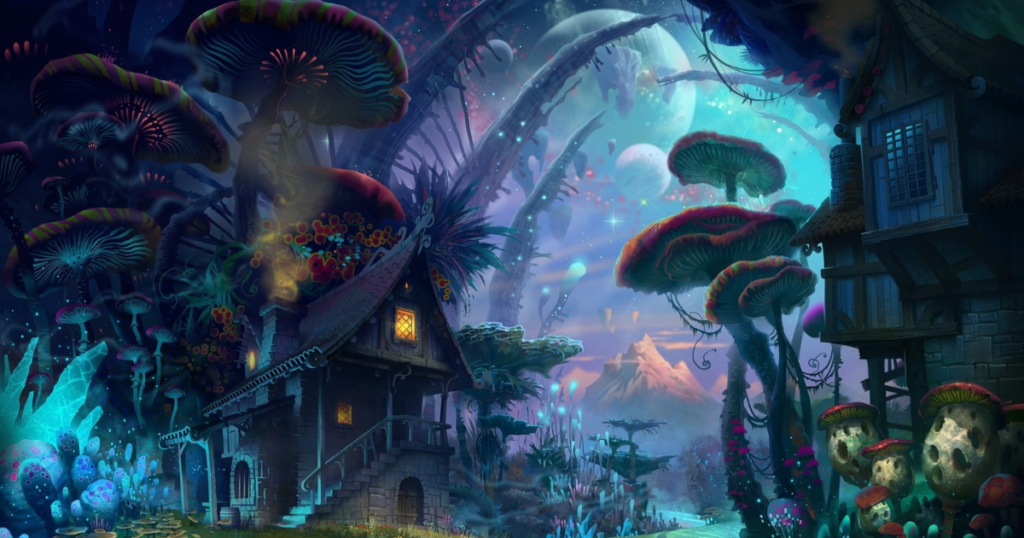
The relationship between mushrooms and human artistic expression stretches back to the dawn of recorded history. Some of the earliest known depictions of mushrooms can be found in prehistoric rock art, suggesting that our fascination with fungi is as old as human culture itself.
Prehistoric Representations
In the caves of Tassili n’Ajjer in Algeria, rock paintings dating back to 5000-7000 BCE depict what some researchers interpret as mushroom-headed shamanic figures. These images, along with similar finds in other parts of the world, have led some scholars to speculate about the ritual use of psychoactive mushrooms in ancient societies and their influence on early artistic expression.
Ancient Civilizations
As human civilizations developed, so too did the artistic representation of mushrooms. In ancient Egypt, mushrooms were associated with immortality and were sometimes depicted in funerary art. The ancient Greeks and Romans, while generally viewing mushrooms with suspicion due to their potential toxicity, occasionally included them in mosaics and frescoes, often as part of larger nature scenes.
Medieval and Renaissance Europe
All through the middle a while and Renaissance, mushrooms began to appear extra often in European artwork, frequently with symbolic or spiritual connotations. In Christian iconography, mushrooms from time to time represented the brevity of lifestyles due to their quick increase and decay. they also seemed inside the margins of illuminated manuscripts, wherein artists had greater freedom to discover fantastical and sometimes subversive imagery.
One exceptional instance from this period is the presence of mushroom-like systems in Hieronymus Bosch’s well-known triptych, “The lawn of Earthly Delights” (c. 1490-1510). These surreal, oversize fungi contribute to the portrayal of dreamlike and now and again nightmarish satisfaction, hinting on the ability of mushrooms to modify belief and focus.
East Asian Traditions
In East Asia, particularly in China and Japan, mushrooms have long held a place of honor in art and culture. The lingzhi mushroom, also known as reishi, has been depicted in Chinese art for over 2,000 years, symbolizing longevity, divine power, and good fortune. It often appears in paintings, sculptures, and decorative arts, sometimes anthropomorphized or combined with other auspicious symbols.
Japanese art also embraced mushroom imagery, particularly in the ukiyo-e woodblock prints of the Edo period (1603-1867). Artists like Utagawa Hiroshige included mushrooms in their nature studies and seasonal landscapes, celebrating the beauty and variety of fungi found in the Japanese countryside.
The Age of Scientific Illustration
As eu botanical technology superior inside the 17th and 18th centuries, a new form of mushroom art emerged: medical instance. Naturalists and artists worked together to create exact, correct depictions of numerous fungal species, combining scientific commentary with creative talent. Those illustrations, observed in early mycology texts and natural history collections, laid the groundwork for contemporary scientific information of fungi even as additionally generating works of outstanding aesthetic fee.
one of the most huge figures in this area became Beatrix Potter, better called the author of children’s books like “The tale of Peter Rabbit.” Before her literary profession, Potter became an accomplished mycological illustrator, producing masses of distinct watercolor studies of fungi. Her work exemplifies the intersection of clinical accuracy and artistic splendor that characterizes the first-rate of mycological illustration.
The Romantic and Victorian Eras
As the Romantic motion swept via Europe within the past due 18th and early 19th centuries, artists started out to view nature, which include mushrooms, through a more emotional and imaginative lens. Mushrooms seemed in pastoral landscapes and woodland scenes, often imbued with an experience of thriller or magic. This fashion continued into the Victorian generation, in which mushrooms became a popular motif in the decorative arts, appearing on the whole thing from textiles to ceramics to jewelry.
The fairy art work that received recognition in Victorian England frequently featured mushrooms as part of their whimsical, otherworldly landscapes. Artists like Richard Dadd and John Anster Fitzgerald created tricky scenes wherein tiny fairies and other magical creatures cavorted amongst oversized toadstools, reinforcing the affiliation between mushrooms and the realm of creativeness and myth.
This historical overview sets the degree for the explosion of mushroom-inspired artwork that might occur inside the 20th and 21st centuries. From their earliest appearances in prehistoric artwork to their role in clinical instance and myth painting, mushrooms have established to be a flexible and enduring difficulty for creative exploration. As we will see inside the following sections, this rich history has laid the foundation for the various and innovative tactics to mushroom art that signify the current scene.
Mushroom Symbolism and Cultural Significance
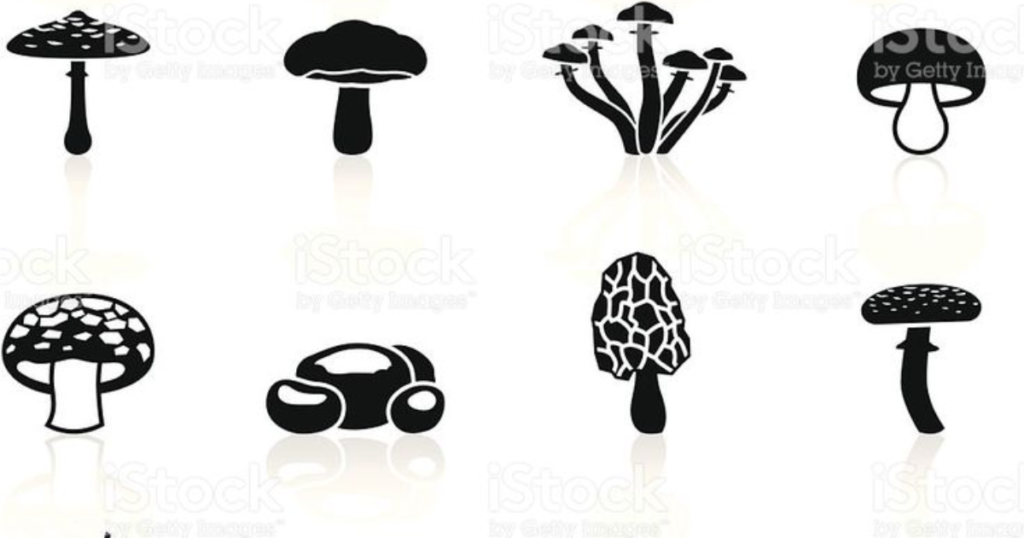
The symbolism of mushrooms in art and culture is as diverse and complex as the fungi themselves. Across different societies and time periods, mushrooms have accrued a rich tapestry of meanings, often reflecting broader cultural attitudes towards nature, spirituality, and human consciousness.
Fertility and Rebirth
In many cultures, the fast increase and surprising appearance of mushrooms after rain have related them symbolically to ideas of fertility and rebirth. This affiliation is particularly robust in a few ecu folkloric traditions, in which fairy rings – circles of mushrooms that seem in fields or forests – had been used to mark websites of magical pastime or gateways to other realms.
The artist Yayoi Kusama, known for her obsessive use of polka dots and phallic paperwork, has regularly incorporated mushroom-like shapes into her paintings. Her installations and sculptures often function as proliferating, organic paperwork that evoke both the fecundity of nature and the hallucinatory reports associated with sure mushroom species.
Mortality and Decay
Conversely, the fast decomposition of many mushroom species has also made them effective symbols of mortality and the transience of life. In Western vanitas art work of the 16th and 17th centuries, mushrooms sometimes seemed along other symbols of deterioration, serving as reminders of the brevity of earthly existence.
Contemporary artists have persevered to explore this theme. The photographer Jill Bliss, as an instance, creates hanging preparations of mushrooms and other decomposing be counted discovered at the wooded area ground, celebrating the splendor inherent inside the cycle of decay and renewal.
Altered States and Spiritual Insight
Perhaps the most potent and controversial symbolism associated with mushrooms relates to their psychoactive properties. The use of psilocybin-containing mushrooms in religious and spiritual contexts has been documented in various cultures, from the ancient Mayans to contemporary indigenous groups in Mexico and Central America.
This connection between mushrooms and altered states of consciousness has had a profound impact on art, particularly in the 20th century. The influence of psychedelic experiences on visual art became explicit in the 1960s counterculture movement, with artists like Fred Tomaselli incorporating mushroom imagery into complex, mandala-like compositions that attempt to capture visionary states.
Even earlier, surrealist artists like Salvador Dalí played with mushroom forms, using their strange, otherworldly shapes to create dreamlike landscapes that challenge ordinary perception. Dalí’s “The Temptation of St. Anthony” (1946) features elongated, elephant-like creatures with fungal growths, blending religious imagery with surreal, possibly psychedelic-inspired forms.
Ecological Interconnectedness
In recent decades, as scientific understanding of fungi has advanced, mushrooms have increasingly come to symbolize the hidden networks that connect ecosystems. The discovery of vast mycelial networks that facilitate communication and resource sharing between plants has inspired a new wave of artistic interpretations.
Artists like Phil Ross have created sculptures and installations using living mycelium, highlighting the organism’s potential as both an artistic medium and a symbol of ecological interconnectedness. Ross’s “Mycotecture” series, which includes furniture and architectural elements grown from fungal materials, blurs the line between art, design, and biology.
Cultural Variations
It’s critical to note that mushroom symbolism can vary drastically between cultures. In many Western contexts, mushrooms have regularly been considered with an aggregate of fascination and worry, associated with poison and chance as much as with magic and thriller. This ambivalence is contemplated inside the “Alice in Wonderland” illustrations through John Tenniel, wherein the caterpillar sits atop a mushroom that could modify Alice’s length – a symbol of both ability and peril.
In contrast, East Asian cultures, mainly China and Japan, have historically held positive mushroom species in excessive esteem. The lingzhi or reishi mushroom, as noted in advance, is a symbol of sturdiness and non secular efficiency, regularly depicted in art and utilized in conventional medicinal drugs. This high quality association has motivated inventive representations, with mushrooms frequently appearing as auspicious symbols in artwork, textiles, and ornamental gadgets.
Folklore and Mythology
Mushrooms play full-size roles in the folklore and mythology of many cultures, frequently straddling the road between the mundane and the magical. In Slavic folklore, for example, mushrooms are on occasion associated with forest spirits or taken into consideration the “youngsters of the woodland.” This mythological connection has inspired several creative interpretations, from conventional folks artwork to present day delusion illustrations.
The Finnish artist and illustrator Klaus Haapaniemi has created a body of labor deeply influenced by Finnish folklore, including mushroom motifs that evoke a sense of enchantment and mystery. His problematic designs, featured on textiles and household gadgets, combine conventional mythological elements with a contemporary aesthetic.
Countercultural Icon
Within the latter half of the 20 th century, the mushroom – specifically the red and white noticed fly agaric (Amanita muscaria) – became something of a countercultural icon. This exceptional mushroom, with its associations to Alice in Wonderland and its records of ritualistic use in a few cultures, became a visible shorthand for psychedelic reports and alternative life.
Artists like Allyson Gray, whose complex, visionary paintings frequently incorporate mushroom bureaucracy and mycological topics, have continued this lifestyle. Grey’s paintings explore the intersection of spirituality, science, and psychedelic revel in, with mushrooms serving as habitual motifs and metaphors.
Environmental Awareness
As ecological concerns have come to the forefront of public consciousness, mushrooms have taken on new symbolic significance in art. Their role in decomposition and nutrient cycling has made them powerful symbols of nature’s regenerative capacities.
The work of Dutch artist Lizan Freijsen exemplifies this trend. Freijsen creates tapestries and rugs inspired by the patterns of mold and fungal growth, transforming what might typically be seen as signs of decay into objects of beauty. These works invite viewers to reconsider their relationship with the often-overlooked processes of decomposition and renewal in nature.
From Microsopic to Cosmic
The visual similarities between microscopic images of mycelial networks and macroscopic views of cosmic structures have not been lost on artists. This parallel has inspired works that play with scale and perspective, using mushrooms and fungal forms to evoke both the infinitesimally small and the unimaginably vast.
The American artist Rogan Brown creates intricate paper sculptures inspired by microscopic organisms, including fungi. His work often features mushroom-like forms that seem to hover between the biological and the cosmic, inviting viewers to contemplate the hidden structures that shape our world at every scale.
In conclusion, the symbolism and cultural significance of mushrooms in art are multifaceted and evolving. From ancient spiritual associations to contemporary ecological metaphors, fungi have proven to be remarkably versatile symbols, capable of embodying a wide range of human experiences and ideas. As our understanding of these organisms continues to grow, it’s likely that artists will find ever new ways to interpret and represent the symbolic potential of mushrooms.
Contemporary Mushroom Art
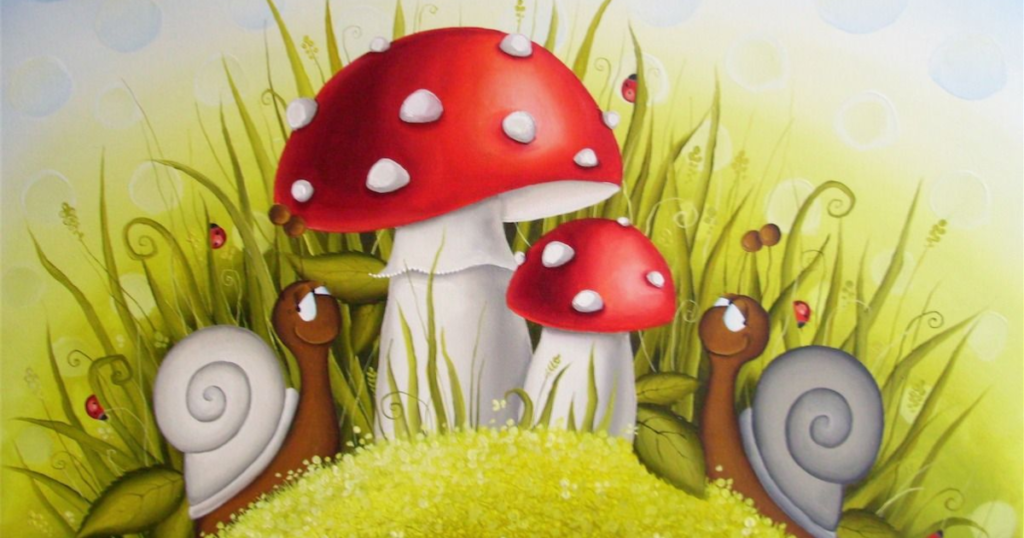
The late 20th and early 21st centuries have seen an explosion of interest in mushrooms as both subject matter and medium in contemporary art. This renaissance in fungal-inspired creativity spans a wide range of styles, techniques, and conceptual approaches.
Sculptural Innovations
One of the most hanging tendencies in present day mushroom art is using fungi as a sculptural medium. Artists are exploring the specific properties of mycelium – the vegetative a part of a fungus along with a network of first-class white filaments – to create sustainable, biodegradable sculptures and installations.
Phil Ross, mentioned earlier, is a pioneer of this discipline. His “Mycotecture” series pushes the boundaries of what’s possible with fungal materials, creating furniture, architectural factors, or even entire systems grown from mycelium. Ross’s work is not handiest of demanding situations; our perceptions of what constitutes art however also points to capability ecological answers in design and production.
In addition, the duo of Julia Lohmann and Gero Grundmann have created a chain of lamps referred to as “Fomes Fomentarius,” named after the species of bracket fungus used in their production. These sensitive, translucent sunglasses showcase the natural beauty of fungal systems whilst reimagining their useful capability.
Textile artist Elin Thomas creates miniature embroidered and crocheted molds and lichens, elevating these frequently-overlooked organisms to the status of valuable objects. Her work blurs the line between scientific specimen and ornamental artwork, inviting visitors to realize the elaborate splendor of fungal forms.
Digital and New Media Art
The digital realm has opened up new opportunities for mushroom-inspired artwork. Artists are using laptop pictures, virtual fact, and generative algorithms to create immersive fungal worlds and explore the complicated networks of mycelial structures.
Android Jones, a virtual artist known for his psychedelic-encouraged work, regularly consists of mushroom imagery into his difficult, fractal-like compositions. His pieces, which regularly blend natural and technological elements, reflect the growing hobby inside the parallels among fungal networks and human-made information structures.
Within the realm of video art, Louie Schwartzberg’s time-lapse cinematography of developing mushrooms, featured in his documentary “remarkable Fungi,” has captivated audiences with its enchanting imagery. Schwartzberg’s paintings bridge the distance between scientific documentation and creative expression, revealing the hidden beauty of fungal existence cycles.
Installation and Environmental Art
Many contemporary artists are creating large-scale installations that immerse viewers in fungal-inspired environments. These works often comment on ecological issues or explore the relationship between humans and the natural world.
Carsten Höller, known for his interactive installations, created “The Fly Agaric Show” in 2010, featuring giant replicas of the iconic red and white spotted mushroom. Viewers could enter these oversized fungi, experiencing a shift in scale that echoes the perceptual changes associated with psychoactive mushrooms.
Environmental artist Nils Udo incorporates living mushrooms into his ephemeral nature installations. His works, which are often photographed and left to decay naturally, highlight the transient beauty of fungi and their role in the cycle of growth and decomposition.
Painting and Illustration
While new media have spread out novel avenues for mushroom art, conventional techniques like portray and illustration continue to be critical modes of fungal expression.
German artist Seana Gavin creates complicated collages and watercolors presenting anthropomorphized mushrooms in surreal, psychedelic landscapes. Her paintings, which often incorporate antique botanical illustrations, reflects a whimsical, neo-Victorian aesthetic that has grow to be famous in modern-day mushroom artwork.
Illustrator Jill Bliss, stated in advance, creates “Nature Medleys” – cautiously organized compositions of mushrooms, plant life, and other natural gadgets found on the forest ground. Photographed towards stark black backgrounds, these works elevate humble fungi to the status of high artwork, celebrating their numerous colorings and paperwork.
Inside the realm of abstract portraiture, artist Marianne Grondahl creates massive-scale works stimulated via the microscopic systems of fungi. Her artwork, which functions with natural shapes and muted earth tones, evoke the hidden worlds of soil ecology and mycelial networks.
Performance and Conceptual Art
Some modern-day artists are using mushrooms in performance and conceptual pieces, often to explore themes of interconnectedness, consumption, and environmental trade.
Artist Tatiana Ginsberg has created overall performance portions involving the cultivation and consumption of mushrooms, blurring the traces among art, agriculture, and ritual. Her paintings regularly involve network participation, highlighting the social and cultural factors of fungi.
Conceptual artist Carsten Höller (stated in advance) has additionally explored fungi in his relational aesthetics works. In his piece “The Mushroom Math Lab,” individuals were invited to solve mathematical problems at the same time as below the affect of fly agaric mushrooms, elevating questions about recognition, belief, and the character of information.
Fashion and Wearable Art
The world of fashion has additionally embraced fungal bureaucracy and concepts. Designers are experimenting with mushroom-based total textiles and growing clothes inspired by means of fungal structures.Stella McCartney has been at the leading edge of incorporating Mylo™, a leather alternative made from mycelium, into excessive-cease fashion designs. This fusion of sustainability, innovation, and high fashion represents a brand new frontier in mushroom-stimulated creativity.
Artist Aniela Hoitink has created a dress made entirely from discs of residing mycelium, which keep growing and trade through the years. This piece demands traditional notions of clothing and explores topics of impermanence and symbiosis between humans and fungi.Rings dressmaker Luciana Uribe creates delicate portions stimulated by way of microscopic photographs of fungi. Her paintings translate the complicated structures of spores and hyphae into wearable artwork, bringing the hidden beauty of the fungal global into normal life.
In the end, contemporary mushroom art is a colorful and numerous discipline, encompassing an extensive range of media, strategies, and conceptual strategies. From conventional painting and sculpture to digital artwork and biotechnology, artists are finding ever new methods to discover the cultured and symbolic ability of fungi. This ongoing inventive engagement with mushrooms reflects broader cultural shifts closer to ecological cognizance, interest in altered states of consciousness, and appreciation for the complicated interconnections that shape our world.
As our medical expertise of fungi keeps to conform, revealing their important roles in ecosystems and ability programs in era and remedy, it is probable that artists will hold to discover ideas in those splendid organisms. The future of mushroom art promises to be as diverse, adaptive, and unexpected as fungi themselves.
Read More:
Creative Dipping Sauces To Pair With Fried Mushrooms
Techniques and Mediums in Mushroom Art
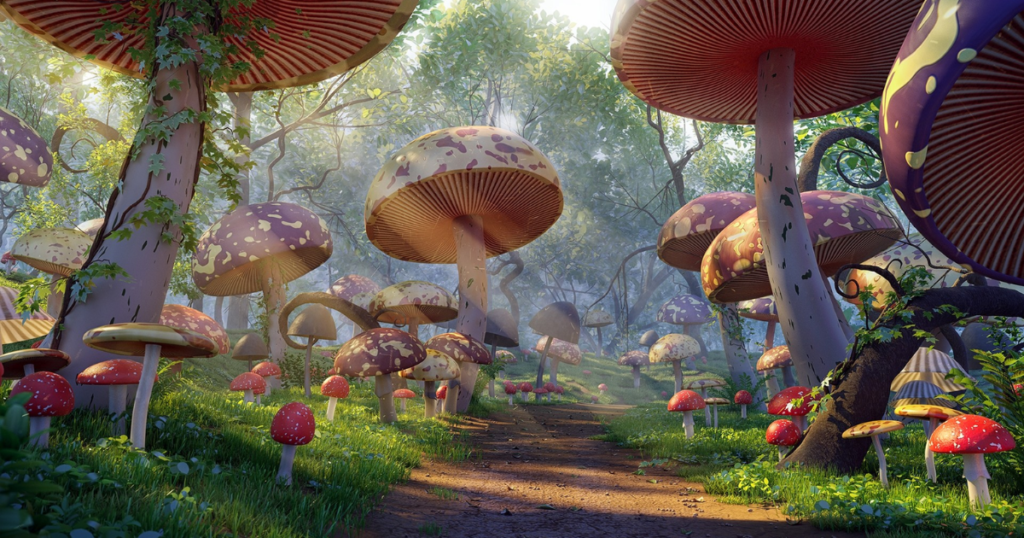
The world of mushroom art is as diverse as the fungi kingdom itself, with artists employing a wide array of techniques and mediums to capture the essence of these fascinating organisms. From traditional methods to cutting-edge technologies, the approaches to creating mushroom art are constantly evolving.
Traditional Fine Art Techniques
Painting
Oil, acrylic, and watercolor paintings remain popular mediums for mushroom art. Artists like Alexander Viazmensky create hyper-realistic watercolor portraits of individual mushroom species, capturing minute details of gills, stems, and caps. In contrast, abstract painters might use mushrooms as inspiration for non-representational works, focusing on the organic shapes and earthy colors associated with fungi.
Drawing and Illustration
Graphite, charcoal, and ink drawings allow artists to capture the delicate textures and intricate structures of mushrooms. Scientific illustrators like Alan Rockefeller combine artistic skill with mycological knowledge to create detailed, accurate renderings of various fungal species. On the other end of the spectrum, fantasy illustrators might use pen and ink to create whimsical, stylized mushroom characters and landscapes.
Printmaking
Techniques like woodcut, linocut, and etching are well-suited to capturing the bold forms and textures of mushrooms. Artists like Alison Holt create intricate mushroom-themed prints that often incorporate elements of pattern and repetition, echoing the fractal-like structures found in many fungal forms.
Sculpture and 3D Art
Clay and Ceramics
The organic shapes of mushrooms lend themselves well to ceramic art. Artists like Charlotte Mary Pack create whimsical ceramic mushroom sculptures, often incorporating elements of fantasy or anthropomorphization. Others, like Japanese ceramicist Yukiko Kitahara, create more naturalistic representations, capturing the delicate textures of mushroom caps and gills in porcelain.
Wood Carving
Wood, being organic and often host to fungi in nature, is a fitting medium for mushroom art. Artists like Mychael Barratt create intricate relief carvings of mushroom scenes, often incorporating other forest elements to create miniature ecosystems.
Metal Work
While perhaps less intuitive than organic materials, metal can be used to create striking mushroom sculptures. Artists might use welding techniques to create large-scale outdoor mushroom installations, or delicate metalworking methods to craft intricate mushroom jewelry.
Mixed Media and Found Object Art
Collage and Assemblage
Artists like Seana Gavin combine vintage botanical illustrations, photographs, and other paper elements to create surreal mushroom-themed collages. Others might incorporate actual dried mushrooms or other natural materials into their assemblages.
Terrarium and Miniature Art
Some artists create miniature mushroom worlds within glass containers, combining live plants, sculpted elements, and sometimes even cultivated fungi to create self-contained ecosystems.
Textile Arts
Embroidery and Needlework: Artists like Amanda Cobbett create incredibly detailed mushroom sculptures using embroidery techniques, capturing the textures of different fungal species through skilled use of thread and fabric.
Felting
The soft, organic qualities of felted wool lend themselves well to mushroom art. Artists create everything from realistic needle-felted mushroom replicas to whimsical felted mushroom characters and landscapes.
Weaving and Tapestry
Large-scale woven works can capture the intricate patterns of mycelial networks or depict fantastical mushroom-filled landscapes.
Digital and New Media Art
Digital Illustration and Painting
Software like Procreate, Photoshop, and Illustrator allow artists to create detailed mushroom illustrations or surreal digital paintings incorporating fungal elements.
3D Modeling and Animation
Artists use programs like Blender or Maya to create three-dimensional mushroom models, which can be used in animations, video games, or as the basis for 3D-printed sculptures.
Generative Art
Some artists write algorithms that generate mushroom-inspired forms, creating ever-changing digital artworks that mimic the growth patterns of fungi.
Virtual and Augmented Reality
Immersive digital experiences allow viewers to explore fantastical fungal worlds or get up close with highly detailed virtual mushroom specimens.
Biotechnology and Living Art
Mycelium Cultivation
Artists like Phil Ross grow sculptural forms directly from living mycelium, creating works that blur the line between art and organism.
Bioluminescent Art
By working with bioluminescent fungal species, artists create living light installations that glow in the dark.
Spore Prints
Some artists create works by capturing the spore prints of mushrooms, resulting in delicate, natural images that are both art and scientific record.
Photography and Film
Macro Photography
Photographers use specialized lenses to capture extreme close-ups of mushrooms, revealing intricate details invisible to the naked eye.
Time-lapse Photography
By capturing the growth cycle of mushrooms over time, artists create mesmerizing videos that compress days or weeks into seconds.
Photomicrography
Using microscopes coupled with cameras, artists capture the hidden world of fungal structures at a cellular level, creating images that often resemble abstract art.
Experimental Techniques
Mushroom Ink
Some artists create their own inks from mushroom species like Coprinopsis atramentaria, also known as the ink cap, resulting in unique, natural pigments.
Mushroom Paper
By incorporating fungal materials into the papermaking process, artists create textured, organic papers that become artworks in themselves.
Mushroom Dyeing
Certain mushroom species can be used to create natural dyes, which artists use on textiles or papers to create subtle, earthy color palettes.Each of these techniques and mediums offers unique possibilities for exploring the world of mushrooms through art. Many contemporary artists combine multiple techniques, pushing the boundaries of what’s possible and finding new ways to represent and work with fungi.
The choice of technique and medium often reflects not just aesthetic preferences, but also conceptual concerns. Artists focused on environmental themes might choose sustainable or biodegradable materials, while those interested in the intersection of art and science might opt for more technologically advanced methods.
As our understanding of fungi continues to grow and technology advances, we can expect to see even more innovative approaches to mushroom art in the future. The field remains ripe for experimentation, with endless possibilities for creative exploration of these fascinating organisms.
FAQs
Why has mushroom art become so popular in recent years?
Mushroom art has surged in popularity due to increased ecological awareness and the growing interest in psychedelic experiences. The unique forms and cultural significance of fungi make them a rich source of artistic inspiration.
What are some common techniques used in mushroom art?
Techniques range from traditional painting and sculpture to innovative approaches like mycelium cultivation and digital art. Artists often combine multiple methods to explore the diverse aspects of fungi.
Can mushrooms themselves be used as art materials?
Yes, many artists use living mycelium or dried mushrooms in their work. This can include growing sculptural forms from mycelium or using mushroom-based dyes and inks.
How does scientific knowledge of fungi influence mushroom art?
Scientific discoveries about fungal networks and their ecological roles often inspire artists. Many contemporary works explore themes of interconnectedness and symbiosis based on mycological research.
Are there any famous museums or exhibitions dedicated to mushroom art?
While there aren’t museums solely dedicated to mushroom art, many natural history museums feature fungal artworks. There have also been several notable exhibitions focusing on mushroom-inspired art in recent years.
Conclusion
Mushroom artwork represents a captivating intersection of technology, culture, and creativity. It displays our evolving relationship with the herbal international and our growing appreciation for the complicated roles fungi play in ecosystems and human society. The diversity of techniques and processes utilized in mushroom artwork mirrors the terrific range determined inside the fungal kingdom itself.
As we hold to uncover the mysteries of fungi, from their ability in biotechnology to their role in retaining wooded area fitness, artists will certainly discover new methods to interpret and represent these excellent organisms. Mushroom art now not only celebrates the beauty and strangeness of fungi but additionally serves as an effective medium for exploring broader themes of interconnectedness, sustainability, and the hidden systems that shape our world.
Whether or not through complicated clinical illustrations, abstract sculptures, or immersive digital stories, mushroom artwork invitations us to look greater intently on the regularly-not noted organisms under our feet and to recollect our area within the huge, interconnected web of existence on the planet.

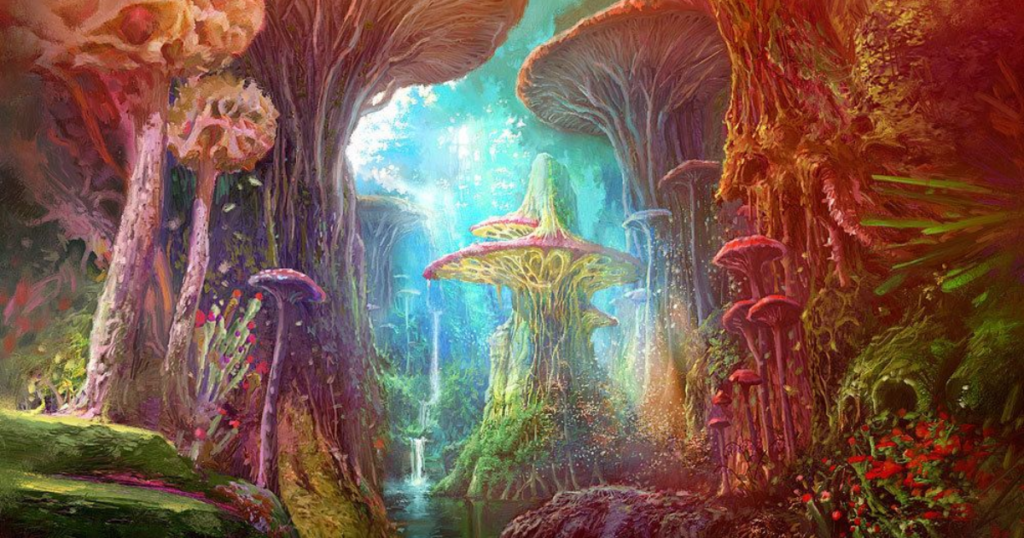
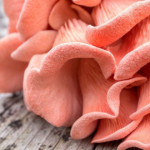
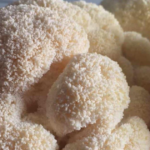
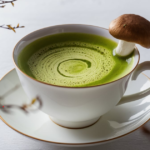

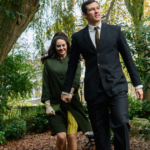
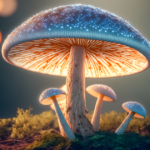
1 thought on “Exploring Mushroom Art”